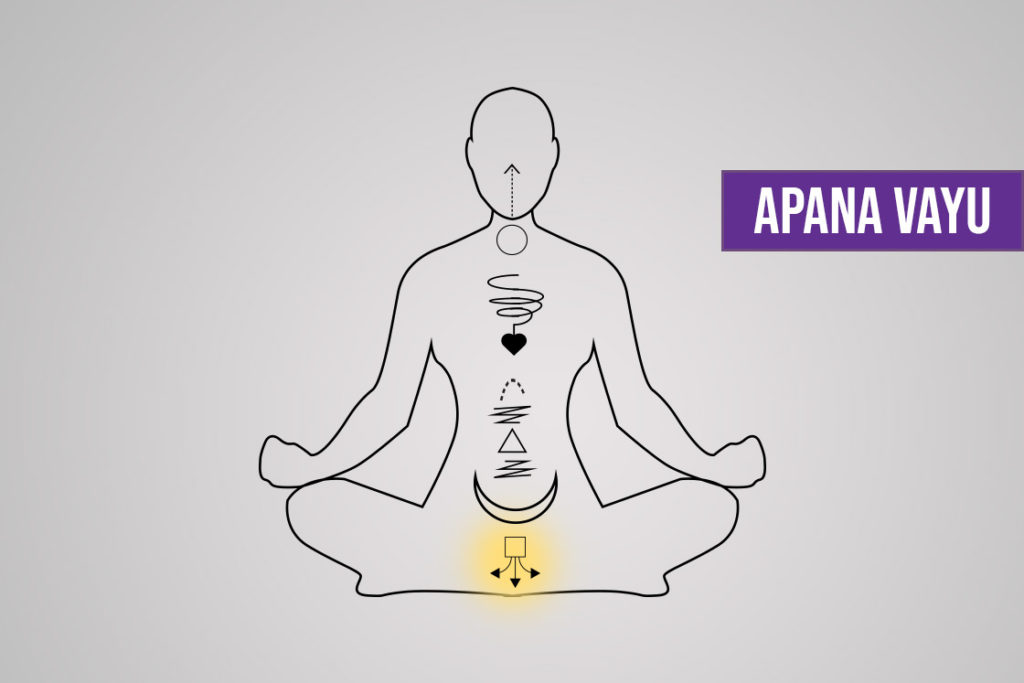Vayu is a Sanskrit word that means “wind”. According to Ayurveda, energy is said to move through the body in specific patterns. The specific pattern of energy is the direction of vayu.
In yoga, it is said that there are 49 vayus in the body that moves in a specific direction therefore associated with specific functions of the body. For example, energy moving around the stomach region is responsible for digestion, it’s Samana Vayu.
Out of 49 vayus, there are only 5 that are important for a yoga practitioner to understand subtle body mechanisms. These are Prana Vayu, Apana Vayu, Samana Vayu, Udana Vayu, and Vyana Vayu. Combinedly these are called 5 Prana Vayus of the body.
The 5 vayus are connected to the 5 elements that make up our body – ether, air, fire, water, and earth. Out of the above vayus, the Apana Vayu is responsible for the downward movement of energy.
In this series of 5 Prana Vayus, we will look into the functions of Apana Vayu and how you can keep it balanced.
What is Apana Vayu?

The term Apana Vayu translates to “the air that moves away”. Apana vayu moves the energy downwards and out from our bodies through our breath, digestive system, and menstruation. Apart from the physical elimination process, it also encourages removing of the mental or emotional elimination process.
The apana vayu is related to the element of earth and the chakra it stimulates is the Muladhara or Root Chakra. Owing to these characteristics, apana vayu is predominantly found in the lower regions of the body, essentially the pelvic floor.
To be more specific, apana vayu is located in the lower abdomen, pelvis, large intestine, and lower regions of the body.
Since this vayu is mostly concerned with the elimination of waste, the genitals, colon, rectum, intestines, kidney, bladder, are the organs where it mostly circulates.
Functions of the Apana Vayu
Whenever you feel an urge of urination or defecation, are experiencing menstruation, or undergoing childbirth, it is your apana vayu that is working towards the process of outward energy flow.
The basic function of the apana vayu is elimination. So even when you are letting go of any destructive or negative thoughts, the apana vayu supports this elimination as well.
Speaking about elimination, the process of digestion, urination, and defecation comes into the picture. The apana vayu encourages the proper absorption of nutrients and water from the food we eat. When the digestive system works properly, it further aids in the formation of feces and urine.
Timely excretion helps in keeping the intestines clean and healthy. Also, releasing of farts reduces pressure in the abdomen and chest which helps in avoiding problems like acidity, heartburn, or stomach ulcers.
Secondly, the optimal and healthy process of ovulation and menstruation is also the responsibility of apana vayu. A healthy ovulation process leads to the fertility and conception of a child. Menstruation is also important for the overall wellness of a woman. The overall functioning of the reproductive system is also governed by the apana vayu.
Apana vayu also helps in childbirth and carrying the pregnancy to full term. The contraction of muscles and pushing of the baby through the uterus during childbirth is also an important function of the apana vayu.
Lastly, it also controls ejaculation, sexual arousal, and a healthy libido. All of this is also responsible for reproduction and conception.
Thus it can be said that whether it is the urge to pass urine or no urge at all, it is the apana vayu that controls all such processes.
Symptoms of imbalance Apana Vayu
The apana vayu is said to be unbalanced when any of the above functions are improper. And since this vayu is also connected to the root chakra, any imbalances in the chakra can also lead to a disturbance in the apana vayu.
When you have excess negative energy and toxins trapped in your body, it can lead to various diseases and illnesses. Some common signs of a vitiated apana vayu are:
- Pain in lower back, thighs, and knees
- Frequent or stagnation in urination
- Constipation, diarrhea, irritable bowel syndrome
- Infertility, problems with menstruation such as PCOD
- Erectile dysfunction, loss of libido
- Laziness, sluggishness
- Fatigue
- Increased self-doubt, insecurity
- Dullness
- Anxiety
- Confusion, disconnection
- Indecisiveness
How to balance the Apana Vayu

Your Apana Vayu can either be in excess or deficient which may result in you experiencing some of the above-mentioned signs. However, it is not difficult to maintain a balance in the flow of apana vayu.
Practising yoga, pranayama, meditation with a mudra, diets and certain lifestyle changes can give you the desired effects.
If you have excess apana vayu symptoms, you need to amp up such practices that will stimulate the prana vayu. Prana vayu moves upwards and inwards as compared to apana vayu which moves downwards and out.
While practicing seated yoga asanas, you can try engaging the Mula Bandha, also known as the root lock. This will help in regulating the movement of the apana vayu in an efficient manner.
For deficient apana vayu (when having constipation, no bowel movement), getting in touch with the earth, due to its connection with the earth element, will help in increasing the circulation. Moreover, you can practice yoga poses that keep you grounded such as chair pose, plank pose, standing splits, etc.
Yoga asanas that are forward bending, standing, or involve seated twists will be beneficial in strengthening Apana vayu. Poses such as Seated forward fold, Bound angle pose, One-legged king pigeon pose, and Tree pose are some good poses to practice.
Kapalbhati Pranayama is one of the most recommended pranayamas that can increase the apana vayu. The forceful exhalation promotes the outflow of the toxins through breath promoting physical as well as mental detoxification.
You can also practice Apana Mudra to promote bowel movements that might be disturbed because of imbalance apana vayu. This mudra is extremely beneficial in regulating and encouraging the free flow of the Apana vayu. To practice, join the tip of the middle and ring finger with the thumb. This hasta mudra can be practiced for 15 minutes 3 times a day. Once you feel the reduction in the symptoms of imbalances, stop practicing this mudra.
Yoga and pranayama are extremely beneficial in giving an overall strength and wellbeing. These practices can also be complemented by other methods such as journaling, a healthy diet of fresh and organic foods, staying grounded to the earth, etc to keep the apana vayu in balance.
Conclusion
The apana vayu is one of the most important vayu in the body. The elimination process is essential to keep the body free from diseases and healthy from the inside. You will notice many bodily problems can be solved if your digestive system and elimination process is working in top condition.
Practicing yoga asanas that massage the digestive system and open the pelvis will work wonders. Also, since vayu is wind, pranayama also plays an important role in keeping the apana vayu balanced.





Really good information, sir. We are thankful to you sir.🙏
Outstanding information for upcoming Generations
Hare Krishna
Thank for the detailed information on management of apana prana. I find this helpful.